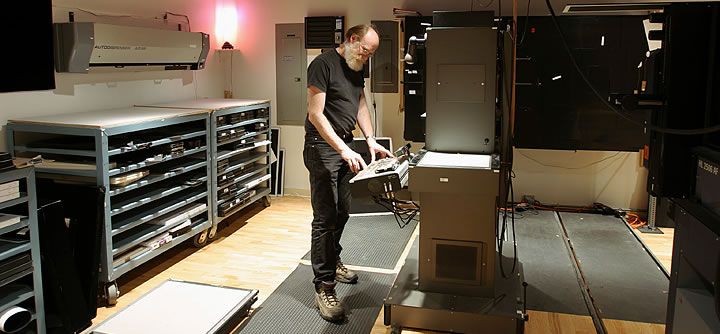Traditional Optical Printing
Christopher’s optical printing methods

The fine print is much more than a mere reproduction of an image. It is the culmination of the inspiration and vision of the photographer. It is the clearest, most direct and powerful form of the image, and has the ability to move beyond words, ideas and concepts to touch and move the viewer in the most direct and immediate way. In its highest form, the fine print can be a transparent vehicle, boldly communicating with whispers and suggestions of worlds previously unseen and unknown. No other form of the image can convey as powerfully the subtleties, the presence and the luminosity which can exist in the fine print. The fine print is, in actuality, the culmination of the photographic creative process; each print can legitimately be considered an original work of art.
One of the unique advantages of photography is that multiple prints can be made of the same image, with tremendous creative interpretation possible in the printing process. The form and framework of the image exists at an intermediate stage within the negative (or transparency), but is unrealized and unmanifested until the creation of the fine print.
The fine print is a vital and necessary part of the whole creative photographic process, and is the final step which conveys to the viewer the essence of what was seen and felt at the moment of exposure of the film. With a complete understanding of all the intermediate steps that lead to culmination in the final print, the photographer can work most effectively with the photographic materials at hand, and can best use the whole process in the most creative way.
To master the photographic process, it is necessary to intuitively understand the nature of light and color; and their interactions with film and sensitized materials, from the moment of exposure to the final print. Only by a complete knowledge of the entire process can a person fully utilize the materials for the clearest and most complete artistic expression.
This is why I am the only one who will print any of my own photographs, both now and in the future. You can be assured that each print is carefully and meticulously printed, one at a time, by myself, to the highest standards. When I print, I spend unlimited time on each image, working to fine-tune the image until it reaches a point that is close to perfection, and expresses that which I see and feel.
Only in this way is it possible for the print to have the ability to speak to the viewer of the mysteries around us; those that fill earth and heaven, and make our souls sing with thanksgiving and praise. This is the purpose and goal I pursue endlessly.
Veracity
“Veracity: The quality or character of speaking the truth; truthful disposition; truthfulness, honesty, trustworthiness.” — Oxford Dictionary
Veracity is at the heart of why I print my work by hand onto conventional photographic materials. My images must be trustworthy if they are to be believable.
When I make a photographic print, my image controls are very simple. I utilize contrast masking to adjust the contrast of the print; dodging and burning to lighten and darken various areas of the image to make it more cohesive; and I adjust the overall color balance to neutralize color casts in the original transparency. I can “stretch and pull” the image in subtle ways, but the integrity of the photographic image is always carefully preserved.
This is vastly different from the multitude of adjustments which are possible in digital imagery; cloning, color saturation, selective color adjustment, color enhancement, image filters, sharpening controls, etc. With digital printing methods, every aspect of the image can be changed and the viewer can be left wondering how much of it is real — or if any of it is real.
Of course, digital printing is here to stay. Talented photographers are utilizing it’s flexible image manipulation capabilities to create unique and interesting work. Many photographers simply use digital printing methods in ways that are similar to conventional optical printing. Much worthwhile work is being done with these new methods.
I believe there is room in the photographic world for both digital and optical printing. Both have their own strengths and weaknesses. But to me, the integrity of the photographic image, (and it‘s direct connection to the original scene), is best preserved using conventional optical printing methods. The very piece of film that was at the original scene is put into the enlarger, projected onto a piece of paper, creating the print which you see before you.
You can be assured that each exhibition print is meticulously handmade by me, one print at a time. Through many hours of patient work, the photograph becomes more refined, as I labor to bring the luminous quality of the image to life. These are not mechanical reproductions, but images in which I have invested my heart and soul. I love it!
As long as I have strength and breath, and as long as my printing materials are available, I will continue to print my work optically, utilizing only conventional photographic materials.
2004